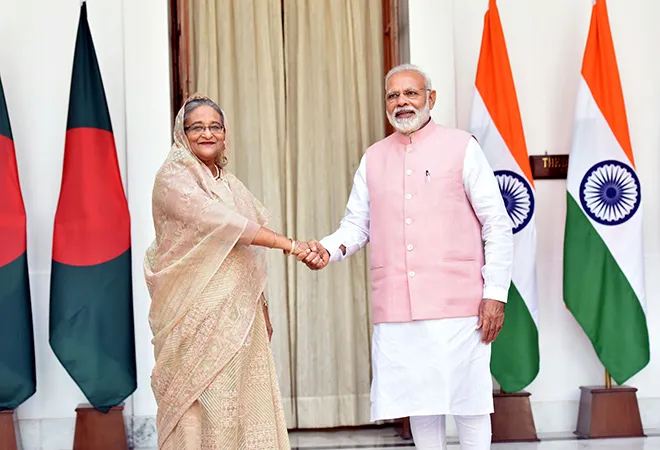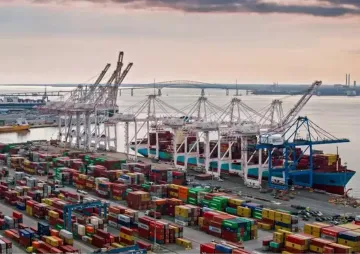
The birth centenary of Bangabandhu Sheikh Mujibur Rahman, Bangladesh’s first president and later prime minister, is being celebrated this year as ‘Mujib Borsho (Mujib Year)’. As we celebrate Bangladesh’s many achievements and its resilience as a society, this is also a moment to reflect on the remarkable trajectory of India-Bangladesh relations. Bangabandhu, the leader of Bangladesh’s freedom struggle, had valued his country’s special relationship with India. His tenure as prime minister of Bangladesh (1972-75) is considered among the finest years of the bilateral relationship. India, too, has constantly nurtured its relationship with Bangladesh and has stood by the side of its neighbour through both heady days and challenging times.
The foundation of the relationship was laid during the liberation struggle of Bangladesh, when India provided shelter to the millions of refugees escaping inhumane treatment in the hands of Pakistani forces. The Indian army also fought shoulder-to-shoulder with the freedom fighters in the liberation war, and contributed to the post-war reconstruction of the newly established nation by providing financial assistance and boots on the ground. Despite some ups and downs over the past five decades, India and Bangladesh have shared a warm and cordial relationship based on mutual trust and a friendship that goes beyond the arithmetic of economic gains and losses.
Indeed, India and Bangladesh are bound by heritage, common values of democracy and secularism, and a shared mutual desire for peace and prosperity for their peoples. Their underlying, fundamental people-to-people ties have driven India and Bangladesh to forge closer cooperation on a range of issues that include security, trade and commerce, and development. Despite the strong strides that India-Bangladesh have made in their relationship, often the discourse seems to be more about the challenges like the Teesta river dispute, and the implications of an assertive China in the region that tends to overshadow the many positive developments in their bilateral engagement.
Despite the strong strides that India-Bangladesh have made in their relationship, often the discourse seems to be more about the challenges like the Teesta river dispute, and the implications of an assertive China in the region that tends to overshadow the many positive developments in their bilateral engagement
To be sure, efforts are being made to address the bilateral issues and smoothen the path to stronger cooperation. For example, Indo-Bangladesh security cooperation has not only helped in the taming of insurgency in India’s northeast but has also been effective in curbing militancy in Bangladesh. The active role of the two countries in containing the network of Jamaat-ul-Mujahideen Bangladesh is clear proof of the success of this cooperation. Intelligence ties between the two nations have grown and border tensions have eased.
Connectivity is another dimension of this partnership which has seen dramatic strides. Worth noting is Bangladesh’s grant of permission to India to use its inland route and ports of Chittagong and Mongla for transhipment of goods to northeast Indian states. This facility will help not only India’s landlocked northeast to gain sea access, but also Bangladesh’s own ambitions of becoming a connectivity hub. Bangladesh’s transportation industry will be a major beneficiary of the transhipment to India’s northeast, as the goods will be transported from Chittagong and Mongla port by road and inland waterways to the Indian border. India’s growing focus on the Bay of Bengal as a maritime space and as a gateway to Southeast Asia makes Bangladesh central to New Delhi’s regional remapping as well as to the broader Indo-Pacific.
Connectivity is another dimension of this partnership which has seen dramatic strides. Worth noting is Bangladesh’s grant of permission to India to use its inland route and ports of Chittagong and Mongla for transhipment of goods to northeast Indian states
New Delhi remains conscious of the grievances in Dhaka, primarily on the trade front. India has been upfront in making special concessions to Bangladesh without any expectations of reciprocity—for instance, it made a unilateral decision to provide duty-free access to Bangladeshi products to its markets (except 25 narcotic substances). Further, India is undertaking measures to reduce existing non-tariff barriers (NTBs) to trade. India is developing the Integrated Check Post in 10 border crossing points with state-of-the-art facilities in an attempt to address NTBs and facilitate trade. Indian efforts have been showing results, as Bangladeshi export to India is growing steadily. In 2019, Bangladesh’s exports to India recorded a 43-percent increase from the previous year, with the total value of trade touching US$1 billion, making it the only country in Asia after Japan where figures have crossed this mark. Bangladesh is now India's biggest trade partner in South Asia.
It was this commitment to a strong partnership that also led to an amicable resolution of the land and maritime boundary disputes between the two countries. The delimitation of the maritime boundary requires a special mention because India gave up around 19, 467 square kilometres of its sovereign rights in the Bay of Bengal without any challenge after the United Nations arbitral tribunal decided in favour of Bangladesh in 2014. At a time when major powers have been treating their international obligations with contempt, India showed respect for the rule of law, giving its bilateral ties with Bangladesh a much needed fillip. India’s move helped Bangladesh gain access to the sea, and to a vast maritime territory rich in hydrocarbon, opening a new vista for its blue economy. The ratification of the Land Boundary Agreement and the successful exchange of enclaves in 2015 are milestones in the relationship.
Moreover, India has provided generous development assistance to Bangladesh. India’s concessional line of credit of nearly USD 10 billion is the largest it has offered to any country. Besides, grant-in-aid forms an important part of India’s developmental assistance in Bangladesh. A significant portion of such grants are utilised to support High Impact Community Development projects like orphanages, student hostels, academic building, cultural centres, etc in Bangladesh. The real strength of India-Bangladesh ties is rooted in the connectivity amongst their peoples. India, for example, has taken efforts in simplifying the visa process for tourists from Bangladesh and 15 lakh visas were issued just in 2019.
India has provided generous development assistance to Bangladesh. India’s concessional line of credit of nearly USD 10 billion is the largest it has offered to any country. Besides, grant-in-aid forms an important part of India’s developmental assistance in Bangladesh
India has also always responded first in Bangladesh’s times of crises, whether in the aftermath of natural disasters like cyclone Sidr (2007), or amidst health emergencies such as the ongoing Covid-19 pandemic. As Covid-19 spread to Bangladesh, India provided medical assistance in the form of test kits, PPE and medicines, as well as online trainings for medical professionals.
Even as India-Bangladesh relations surge, however, now is not the time to shift gears. There are numerous challenges that are likely to bring major regional and global disruptions— power shifts, climate change, maritime insecurity, and the Fourth Industrial Revolution. Domestic politics and third parties have and will continue to intrude but India and Bangladesh together have to play a pivotal role in transforming the lives of their people and realising Bangabandhu’s vision of a ‘Golden Bengal.’ As the two nations celebrate ‘Mujib Borsho’ this year and the 50th year of the liberation of Bangladesh, as well as the establishment of their diplomatic relations next year, both should be cognisant of each other’s priorities as well as the rapidly shifting geopolitical and geoeconomic terrain around them. Policymakers in New Delhi and Dhaka should not lose sight of how it is not only their histories that are intertwined, but more importantly, their futures.
The views expressed above belong to the author(s). ORF research and analyses now available on Telegram! Click here to access our curated content — blogs, longforms and interviews.




 PREV
PREV



